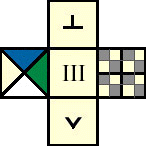Tapestry Chess
This game was inspired by Darren Izzard's Philosopher's Chess, in which a small "control" board is used to influence movement on a larger "playing field" board. The other inspiration for this game was Grid Chess. In his game, Darren chose a theme of philosophy, whereas for this game, I thought of the Greek myth of the Fates: The Fates were represented by three sisters that spun threads. Clotho (the "Spinner") was the goddess that spun the thread into life; Lachesis (the "Dispenser of Lots") weaved the thread into a pattern, assigning destiny to each individual; and Atropos (the "Inexorable") ended the life, by cutting the thread of life.So, I decided to make my "control" board, the loom upon which the Fates spun the threads of destiny. I then thought to name my "playing field" board the Tapestry.
The Board
The playing surface is made up of two boards. One is called the Tapestry and is a 6x6 4-color board, the other is a five-square board in the shape of a plus-sign and is called the Loom. The makes a total of 41 squares, which just happens to be the number of squares required for this to be an entry in the 41 square contest.
+---+---+---+---+---+---+ +---+
| r | b | q | k | b | n | | O | O = Opposition
+---+---+---+---+---+---+ +---+---+---+ L = Light
| p | p | p | p | p | p | | L | N | E | N = Nexus
+---+---+---+---+---+---+ +---+---+---+ E = Earth
| | | | | | | | A | A = Avoidance
+---+---+---+---+---+---+ +---+
| | | | | | |
+---+---+---+---+---+---+ T H E
| P | P | P | P | P | P | L O O M
+---+---+---+---+---+---+
| R | B | Q | K | B | N |
+---+---+---+---+---+---+
THE TAPESTRY

The Tapestry |

The Loom |
The Rules
The rules of FIDE chess apply except where as noted below.Three pieces start on the cental square of the Loom. These are the Fates: Lachesis, Clotho and Atropus. They may move one square orthogonally, and may occupy the same square. They are never removed from the Loom. In this game, the Fate pieces function as generic place- holders and have no unique capabilities.
The five squares of the Loom are called: Light, Earth, Opposition, Avoidance, and Nexus.
- Light: If one or more pieces occupy the Light square, then all pieces on the Tapestry must begin and end their moves on different colored squares.
- Earth: If one or more pieces occupy the Earth square, then all pieces on the tapestry must begin and end their moves in different territories (a territory being one of the 2x2 regions that the Tapestry is divided up into).
- Opposition: If one or more pieces occupy the Opposition square, then pawns may move and capture one square orthonogally forward and sideways.
- Avoidance: If one or more pieces occupy the Avoidance square, then pawns may move and capture one square diagonally forward.
- Nexus: A piece occupying the central square (Nexus) allows pawns to move as in orthodox chess. It also restricts pieces to moving at most 3 squares.
The pieces on the Tapestry move as in orthodox chess, except:
- Piece movement can be restricted according to the pattern of pieces on the Light, Nexus and Earth squares.
- Pawns will have varying movement capabilities based on the pattern of pieces on the Opposition, Avoidance and Nexus squares.
- There is no castling.
- There is no initial two-square pawn move.
Pawns do promote on the 6th rank, and may promote to a Queen, Rook, Bishop or Knight.
A player may take one of two actions on their turn:
- Move and/or capture with one piece on the Tapestry.
- Move one piece on the Loom.
Any piece on the Loom may be moved, however, a player may not undo the move his opponent has just made on the Loom. If a player is unable to move, then that player has lost the game. Check and Checkmate as in orthodox chess.
Notes
Knights are very powerful in this game, as they are never influnced by the Loom.If there are no pieces on the vertical axis of the Loom, then pawns cannot move. If there are no pieces on the horizontal axis of the Loom, then there is no restriction on the movement of pieces (except for those indicated by the pieces themselves).
Thanks to Fergus Duniho for helping to playtest the game, and for creating playing materials for the Tapestry and Loom.
Zillions of Games Implementation
Peter Aronson has kindly implemented this game using Zillions of Games. If you have Zillions, you may download the game (tapestry.zip (8k)) and try it out!Thanks Peter!
Written by David Howe.
WWW page created: 22 Nov 2000. Last modified: 28 Nov 2000.